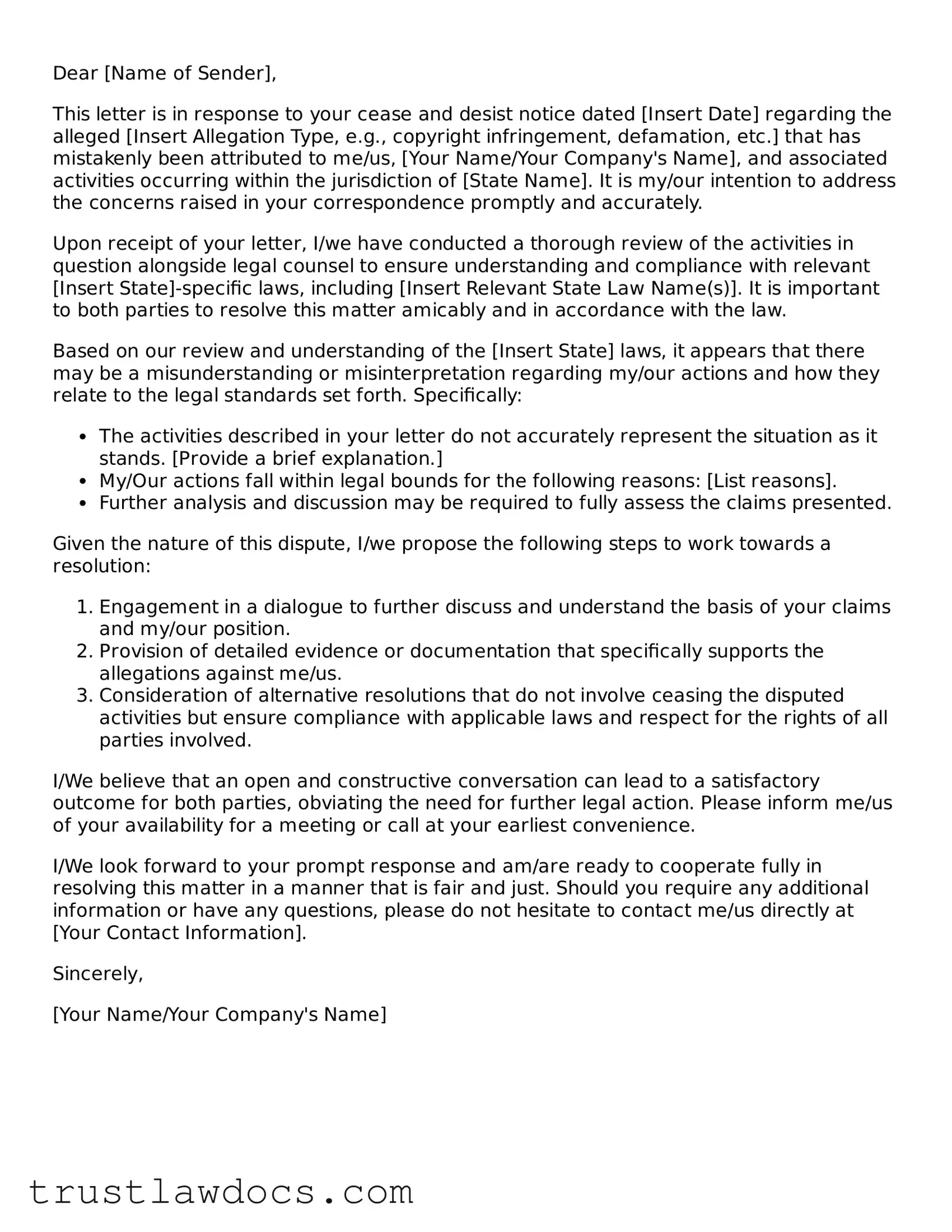What is a Response to a Cease and Desist Letter?
When someone believes you're infringing on their legal rights and sends you a cease and desist letter asking you to stop, a Response to a Cease and Desist Letter is your opportunity to reply. This document allows you to address the claims, agree to cease the disputed activities, propose an alternative resolution, or refute the allegations put forth against you.
Why should I respond to a Cease and Desist Letter?
Responding to a cease and desist letter is crucial because it allows you to clarify your position, negotiate terms, possibly resolve the dispute without legal action, or prepare your defense if the matter escalates. Ignoring the letter can lead to the issuer taking further legal action, including filing a lawsuit against you. A thoughtful response can often de-escalate a situation or lead to a favorable compromise for both parties.
What should be included in my response?
In your response, clearly address each claim made in the cease and desist letter. If you believe the claims are without merit, provide evidence or arguments to support your position. Should you agree with the claims, outline the steps you'll take to cease the offending activities. You can also propose a settlement or request more information to better understand the allegations. It's important to be clear, respectful, and to the point.
Do I need a lawyer to respond to a Cease and Desist Letter?
While it's not mandatory to have a lawyer respond to a cease and desist letter, consulting with one can be beneficial. Lawyers can provide valuable legal advice, ensure your rights are protected, and help craft a response that effectively addresses the issues without admitting any wrongdoing inadvertently. They can also negotiate on your behalf if a settlement is on the table.
What happens if I ignore a Cease and Desist Letter?
Ignoring a cease and desist letter can lead to escalated legal action from the sender, including lawsuits. Courts may perceive ignoring the letter as an admission of guilt or an indication that you don't take the allegations seriously, potentially unfavorably impacting any future legal proceedings. It's advisable to respond even if you believe the claims are unfounded.
Can I use a template for my response?
Using a template as a starting point for your response can be helpful to ensure you cover all necessary aspects. However, it's important to tailor the response to the specific claims and circumstances of the dispute. A generic response may not effectively communicate your stance or could even escalate the situation if it appears dismissive.
How long do I have to respond to a Cease and Desist Letter?
The cease and desist letter often includes a specified timeframe for you to respond, typically ranging from a few days to a couple of weeks. It's important to adhere to this timeline to show you're taking the matter seriously. If you need more time to consult with a lawyer or gather information, consider reaching out to the sender to request an extension.
Can responding to the letter admit guilt?
Carefully wording your response is crucial as it can be used in further legal proceedings. A well-crafted response should clarify your position without admitting guilt or wrongdoing. That's where legal counsel can be invaluable, helping to navigate the complexities of legal communication to protect your interests fully.
What if I've already stopped the activity the Cease and Desist Letter addresses?
If you've already ceased the disputed activity before receiving the letter, your response should clearly state this fact, including any relevant dates of action taken. This could help in resolving the dispute more quickly, demonstrating your compliance and willingness to avoid legal conflicts.
